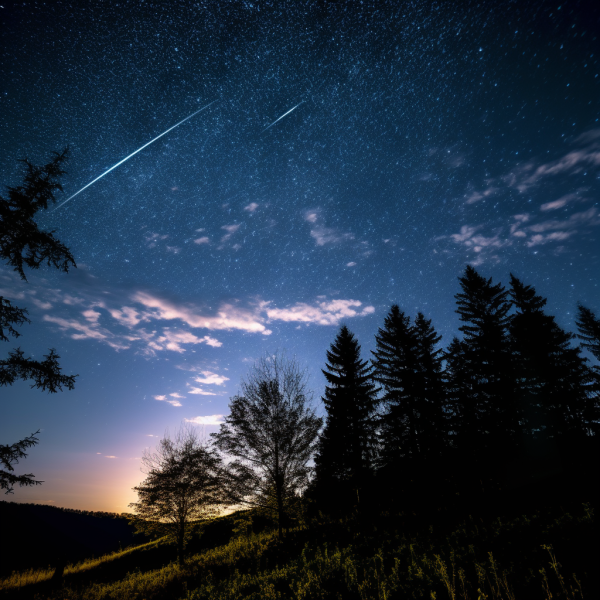Perseids Alert: Best meteor shower of the year peaks this weekend

The Perseids have arrived! With no full moon to interfere, all that is required is a clear sky, darkness, and some patience.
As the Earth passes through the dusty debris of comet Swift-Tuttle’s tail, the annual meteor shower peaks on Saturday night and Sunday morning.
Unlike in previous years, when the Perseids peaked on a weeknight and kept us awake at work and school, this astronomical event occurs on a weekend.
“It’s very nice of nature to cooperate like this,” said astronomer Andrew Fraknoi of the University of San Francisco’s Fromm Institute. “It’s a great courtesy on the part of the universe.”
The moon, an 8%-illuminated crescent, won’t rise until around 3 a.m. Sunday, brightening the eastern sky only as dawn begins.
“Shooting stars” are bits of rock or dust particles heated to incandescence as they hurl through Earth’s atmosphere at unimaginable speed, according to astronomy teacher Don Jolley of DarkSky West Marin, a volunteer-led effort to earn coveted DarkSky Community designation for towns from Woodacre and Stinson Beach to Marshall, preserving the nighttime environment from the harmful effects of light pollution.
“Most are smaller than a pea and disintegrate before they reach our planet’s surface, but larger ‘fireballs’ sometimes survive the fall to Earth,” he explained.
In 1862, American astronomers Lewis Swift and Horace Tuttle discovered Comet Swift-Tuttle. While the 16-mile-wide comet could cause significant damage if it collided with Earth, astronomers believe its orbit will remain stable for the next 2,000 years.
Because comets are remnants of our solar system’s early days, each flash of light is the “last gasp” of a piece of cosmic material that formed 5 billion years ago, according to Fraknoi.
Because Swift-Tuttle orbits the sun, we cross its long trail on the same dates every year: August 12-13.
And the meteors may appear to originate from the same location: the constellation Perseus, just below Cassiopeia’s “W.” The meteor shower got its name from this.
The stars of the celebrated Greek mythological hero reside at great distances and have nothing to do with meteor formation. Rather, they fall from the sky into our planet’s atmosphere.
“They can happen anywhere in the sky,” Fraknoi explained. “There is no specific location or direction in which you wish to look.”
Not to be outdone, the Bay Area’s famous summer fog is expected to linger in San Francisco and coastal areas throughout the weekend. Because this marine layer of low cloud is tightly hugging the California coast, causing “Fogust,” the best viewing will be inland.
Start your meteor watch around 10 p.m. If you’re watching in the early evening, don’t be surprised if you only see a handful of streaks across the sky. Meteor showers are more common after midnight. The later you leave, the better the show and higher in the sky.
According to Jolley, this is due to Earth spinning through space.
“In the hours between sunset and midnight, our view into space shows where we’ve been – a lot like looking into a rear-view mirror as we drive down the highway,” he explained.
“On the other hand, in the hours between midnight and sunrise,” he explained, “a view into space shows where we’re headed – like peering through a windshield, into a rain of falling stars.”
Perseids arrive in pieces, either singly or in short bursts, at a rate of nearly one per minute. They are most visible in very dark places, such as the Point Reyes Peninsula or the Sierra Nevada if there is no fog. A light-pollution map — https://www.lightpollutionmap.info — can assist you in locating the darkest skies near your home.
The number of visible meteors decreases as one gets closer to cities. However, some streaks will be bright enough to cut through the Bay Area’s light pollution. While they are unpredictable, you should expect to wait five to ten minutes to see one.
While you’re waiting, look at “The Summer Triangle.” When seen from above, it is made up of three bright stars in three different constellations: Vega, Deneb, and Altair.
The Milky Way, a river of stars with gossamer beauty, passes through this triad of stars.
Are you going to be busy on Saturday night? Because of the time it takes for Earth to cross the comet’s orbit, you may be able to see Perseids’ streaks for a few more days.
And there’s some solace in knowing that our planet is constantly bombarded with meteoric debris. According to Jolley, studies in Antarctica, where debris is preserved in layers of annual snowfall, estimate that 5 to 40 tons of interstellar stuff falls on Earth every day.
There are traces of cosmic dust and dirt all around us. Simply look down.
“As much as 25% of the dust on the ground arrived from space,” Jolley said.
Tips for spotting the Perseids from astronomer Andrew Fraknoi:
- Get away from city lights and find a relatively dark location.
- Choose a location that allows you to see as much as possible.
- You’re out of luck if it’s significantly foggy or cloudy.
- Give your eyes at least 10 to 15 minutes to adjust to the darkness. Don’t check your phone.
- Avoid using a telescope or binoculars because they limit your view and you want to see the entire sky.
- Dress warmly – even in August, it can get cool at night.
- Have patience. It isn’t fireworks! Continue to look up and around, admiring the constellations, and you’ll notice faint flashes of light.






